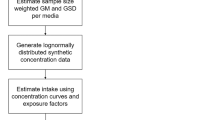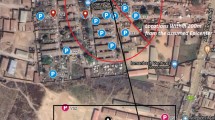Abstract
NHEXAS AZ is a multimedia, multipathway exposure assessment survey designed to evaluate metals and other analytes. This paper reports the analyte-specific concentration distributions in each of the media examined (air, soil, house dust, food, beverage, and water), for various methodologies used (inductively coupled plasma-atomic emission spectroscopy and hydride generation-atomic absorption spectroscopy). Results are reported for the five primary metals (Pb, As, Cd, Cr, and Ni). Ingestion was the most important pathway of exposure. Metal concentrations in air were very low (ng/m3) and found only above the 90th percentile. Metals were commonly found in house dust and soil. Exposure transfer coefficients minimize the importance of this component for those over the age of 6 years. When ranked by exposure, food, beverage, and water appeared to be the primary contributors of metal exposure in NHEXAS AZ. For instance, at the 90th percentile, Pb was undetected in air, found at 131 and 118 µg/m3 in floor dust and soil, respectively, and measured at 16 µg/kg in food, 7.1 µg/kg in beverage, and 2.0 and 1.3 µg/l in drinking and tap water, respectively. We calculated preliminary estimates of total exposure (µg/day) for each participant and examined them independently by age, gender, and ethnicity as reported by the subjects in the NHEXAS questionnaire. At the 90th percentile for Pb, total exposures were 64 µg/day across all subjects (n=176); adult men (n=55) had the greatest exposure (73 µg/day) and children (n=35) the least (37 µg/day). Hispanics (n=54) had greater exposure to Pb (68 µg/day) than non-Hispanics (n=119; 50 µg/day), whereas non-Hispanics had greater exposure for all other metals reported. These results have implications related to environmental justice. The NHEXAS project provides information to make informed decisions for protecting and promoting appropriate public health policy.
This is a preview of subscription content, access via your institution
Access options
Subscribe to this journal
Receive 6 print issues and online access
$259.00 per year
only $43.17 per issue
Buy this article
- Purchase on Springer Link
- Instant access to full article PDF
Prices may be subject to local taxes which are calculated during checkout
Similar content being viewed by others
Author information
Authors and Affiliations
Corresponding author
Rights and permissions
About this article
Cite this article
O'ROURKE, M., VAN DE WATER, P., JIN, S. et al. Evaluations of primary metals from NHEXAS Arizona: distributions and preliminary exposures. J Expo Sci Environ Epidemiol 9, 435–445 (1999). https://doi.org/10.1038/sj.jea.7500049
Published:
Issue Date:
DOI: https://doi.org/10.1038/sj.jea.7500049



